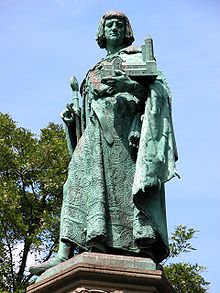Heinrichsbrunnen (Braunschweig)

The Heinrichsbrunnen is a historicist ornamental fountain in Braunschweig from 1874 , the bronze figure of which depicts Duke Heinrich the Lion . It is centrally located on the Hagenmarkt in the Weichbild Hagen .
history
The Weichbild Hagen was founded around 1160 by Duke Heinrich the Lion. At the place of today's Heinrichsbrunnen on the Hagenmarkt there was a medieval bronze fountain from the year 1407 with a figure of Saint Catherine , the patroness of the neighboring Katharinenkirche . This was gilded in 1570 and melted down during the Wars of Liberation in 1814 in order to cast cannons from it.
19th century
In the years 1864 to 1866 the former opera house on the Hagenmarkt was torn down, creating a spacious square. This should be adorned with a fountain statue of Henry the Lion. The sculptor Adolf Breymann , who comes from Braunschweig and works in Dresden , created a model of the statue in 1866. The committee founded to promote the construction of a well to build a well with the statue of Duke Henry the Lion called for financial donations. The committee included the lawyer Adolf Aronheim , the state counsel Johann Wilhelm Oesterreich and the city architect Carl Tappe . The sculptor Breymann was commissioned to create an eight-foot-tall clay model of the Heinrich figure. The model was completed in July 1869 and exhibited in the Aegidienkirche for an entrance fee to finance the planned bronze casting. City planner Carl Tappe commissioned his young assistant, the architect Ludwig Winter , who had been working in Braunschweig again since 1869/70, with the planning of the fountain . He had already gained experience with the design of monumental fountains from his academic teacher Friedrich von Schmidt . Winter sent Breymann a draft to Italy in May 1870. Further designs by Winter, which included Breymann's requests for changes, were discussed by Breymann in Rome with the Viennese architect Heinrich von Ferstel . The preferred design was implemented as a model by Winter 1871. After the financial means enabled the bronze figure of Heinrich to be cast by the Brunswick ore caster Georg Ferdinand Howaldt , the statue was shown at the Vienna World Exhibition in 1873 , where it received an award. The fountain was built the following year and inaugurated on July 4th, 1874. Brunswick citizens donated around 3,800 thalers for the construction.
20th century
While the inner city of Braunschweig was 90% destroyed during the Second World War, the Heinrichsbrunnen survived this time largely unscathed. In the following decades, however, the fountain was badly damaged by exhaust gases and pigeon droppings, so that extensive restoration was necessary at the end of the 1990s. This was carried out in 1998/99 for around 280,000 euros. Today, the city of Braunschweig spends annual cleaning costs of 2000 euros on the Heinrichsbrunnen.
construction
The 274 cm tall bronze figure standing on a bundle of pillars shows an idealized representation of Duke Henry the Lion. Based on the medieval tomb of Heinrich in Brunswick Cathedral , the fountain figure bears the attributes of sword and church building, although the Heinrichsbrunnen is a model of the Katharinenkirche and not the collegiate church of St. Blasius. The fountain bowls in neo - Gothic three - pass shape on two levels made of Velpker sandstone come from Ludwig Winter. Breymann modeled three bronze dragons and three seated lions that were cast by Howaldt. The lions bear the coat of arms of the Welfenhaus . The hexagonal base of the bronze figure is adorned with the coats of arms of the five Braunschweiger Weichbilde and the inscription Henricus Leo .
Impressions
See also
literature
- Britta Berg: Heinrichsbrunnen . In: Braunschweiger Stadtlexikon , published on behalf of the city of Braunschweig by Luitgard Camerer, Manfred RW Garzmann and Wolf-Dieter Schuegraf with special assistance from Norman-Mathias Pingel, Braunschweig 1992, p. 103, ISBN 3-926701-14-5 .
- Wolfgang Kimpflinger: Monument topography Federal Republic of Germany . Monuments in Lower Saxony , Volume 1.1 .: City of Braunschweig , Part 1, Verlag CW Niemeyer, Hameln 1993, ISBN 3-87585-252-4 , p. 170
- Monika Lemke-Kokkelink : From Heinrichsbrunnen to the Romanesque Festival - Stadtbaurat Ludwig Winter (1843-1930) as architect and director of the Heinrichskult in Braunschweig . In: Jochen Luckhardt and Franz Niehoff (eds.): Heinrich der Löwe und seine Zeit , catalog of the exhibition Braunschweig 1995, volume 3 Nachleben department, Munich 1995, pp. 74–82.
- Monika Lemke-Kokkelink: Ludwig Winter (January 22, 1843 - May 6, 1930). City planning officer and architect of historicism in Braunschweig. Catalog for the exhibition on the occasion of the 150th birthday in the Braunschweig town hall from October 12 to November 12, 1993 , In: Braunschweiger Werkstücke , Volume 86, Braunschweig 1993, pp. 118–120.
- Götz Mavius: Monuments in the City of Braunschweig in the 19th Century , Issue 7 of the series Small Writings of the City Archives and the City Library, Braunschweig 1981.
Web links
- Information about the Heinrichsbrunnen on the website of the city of Braunschweig
- Brief description on the website of the German Foundation for Monument Protection
Individual evidence
- ^ German Foundation for Monument Protection, May 2006
- ^ Buzzard should hunt pigeons , Braunschweiger Zeitung, January 29, 2004
Coordinates: 52 ° 16 ′ 1.84 ″ N , 10 ° 31 ′ 27.49 ″ E





